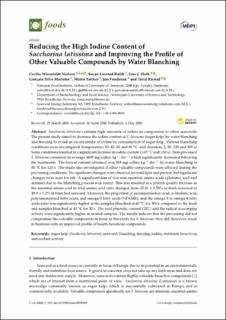| dc.description.abstract | Saccharina latissima contains high amounts of iodine in comparison to other seaweeds. The present study aimed to decrease the iodine content of S. latissima (sugar kelp) by water blanching and freezing to avoid an excess intake of iodine by consumption of sugar kelp. Various blanching conditions were investigated (temperature; 30, 45, 60 and 80 °C, and duration; 2, 30, 120 and 300 s). Some conditions resulted in a significant decrease in iodine content (≥45 °C and ≥30 s). Non-processed S. latissima contained on average 4605 mg iodine kg−1 dw−1 which significantly decreased following the treatments. The lowest content obtained was 293 mg iodine kg−1·dw−1 by water blanching at 80 °C for 120 s. The study also investigated if other valuable compounds were affected during the processing conditions. No significant changes were observed for total lipid and protein, but significant changes were seen for ash. A significant loss of two non-essential amino acids (glutamic acid and alanine) due to the blanching process was found. This also resulted in a protein quality increase as the essential amino acid to total amino acid ratio changed from 42.01 ± 0.59% in fresh seaweed to 48.0 ± 1.2% in blanched seaweed. Moreover, the proportion of eicosapentaenoic acid, α-linolenic acid, polyunsaturated fatty acids, and omega-3 fatty acids (%FAME), and the omega-3 to omega-6 fatty acids ratio was significantly higher in the samples blanched at 60 °C for 300 s compared to the fresh and samples blanched at 45 °C for 30 s. The total phenolic content (TPC) and the radical scavenging activity were significantly higher in treated samples. The results indicate that the processing did not compromise the valuable compounds in focus in this study for S. latissima; they did, however, result in biomass with an improved profile of health beneficial compounds. | en_US |

